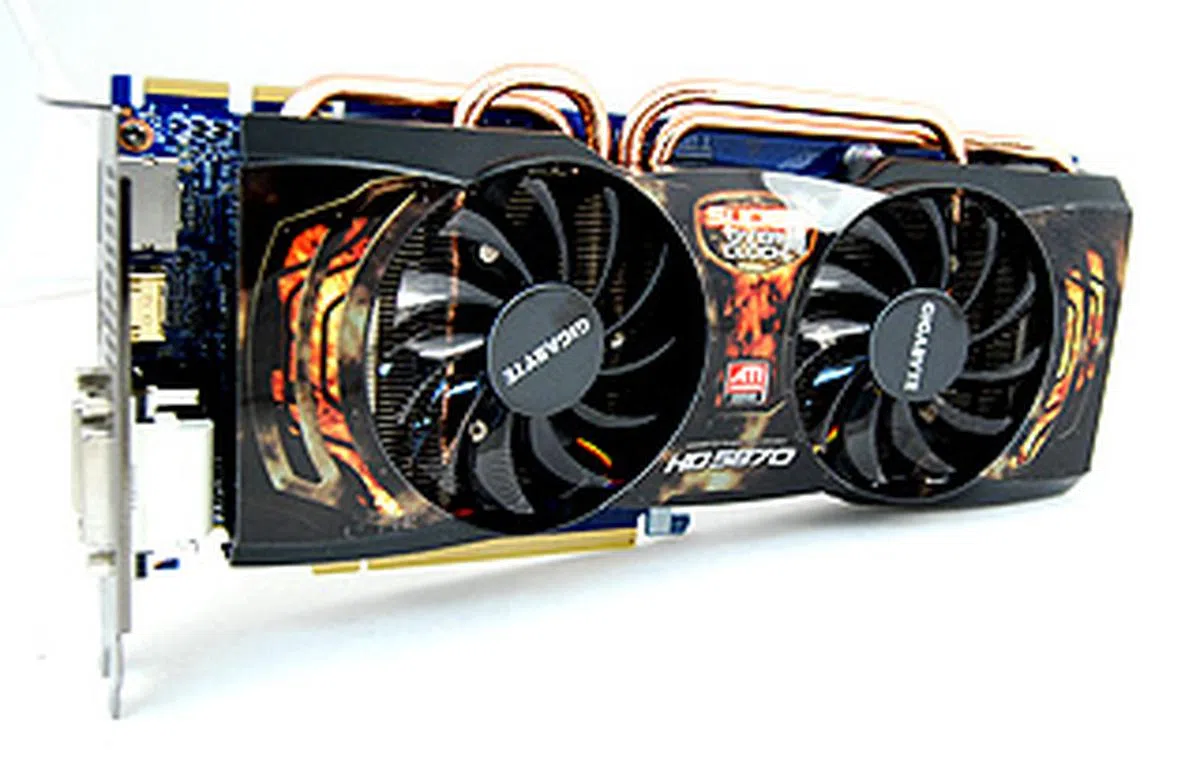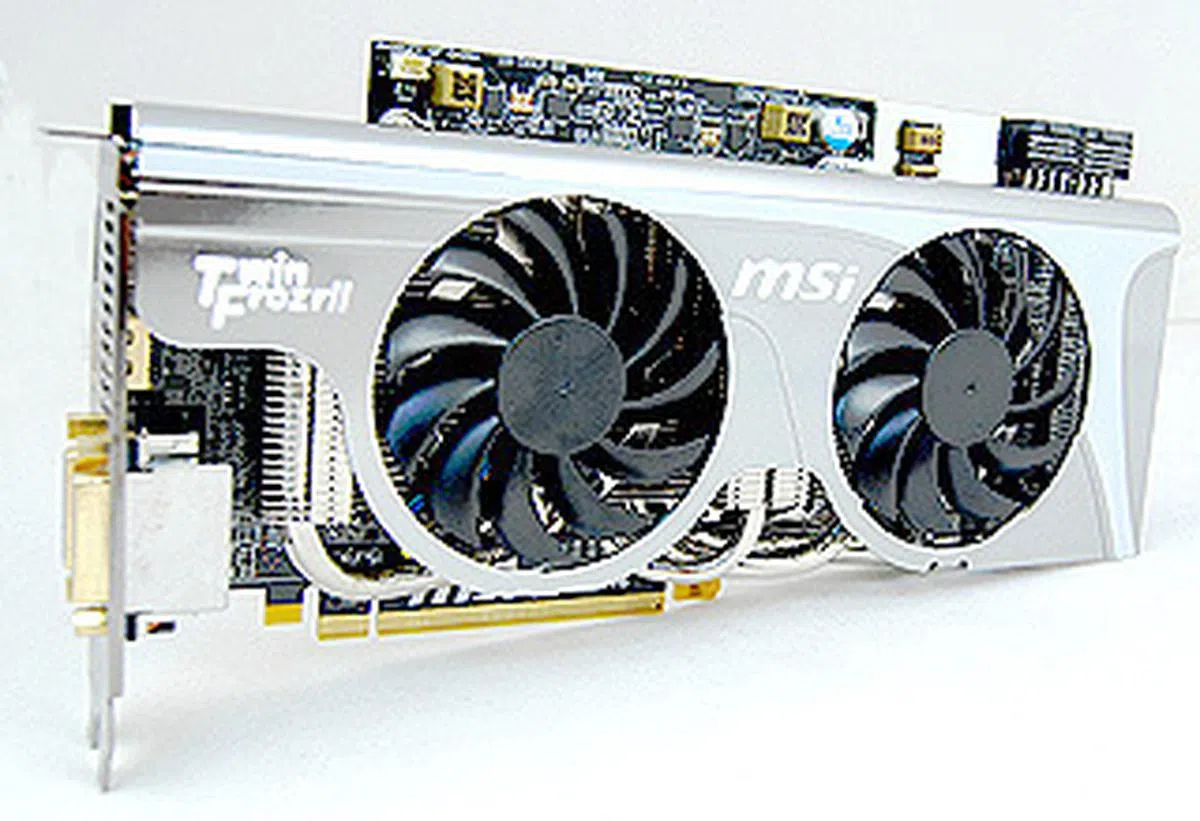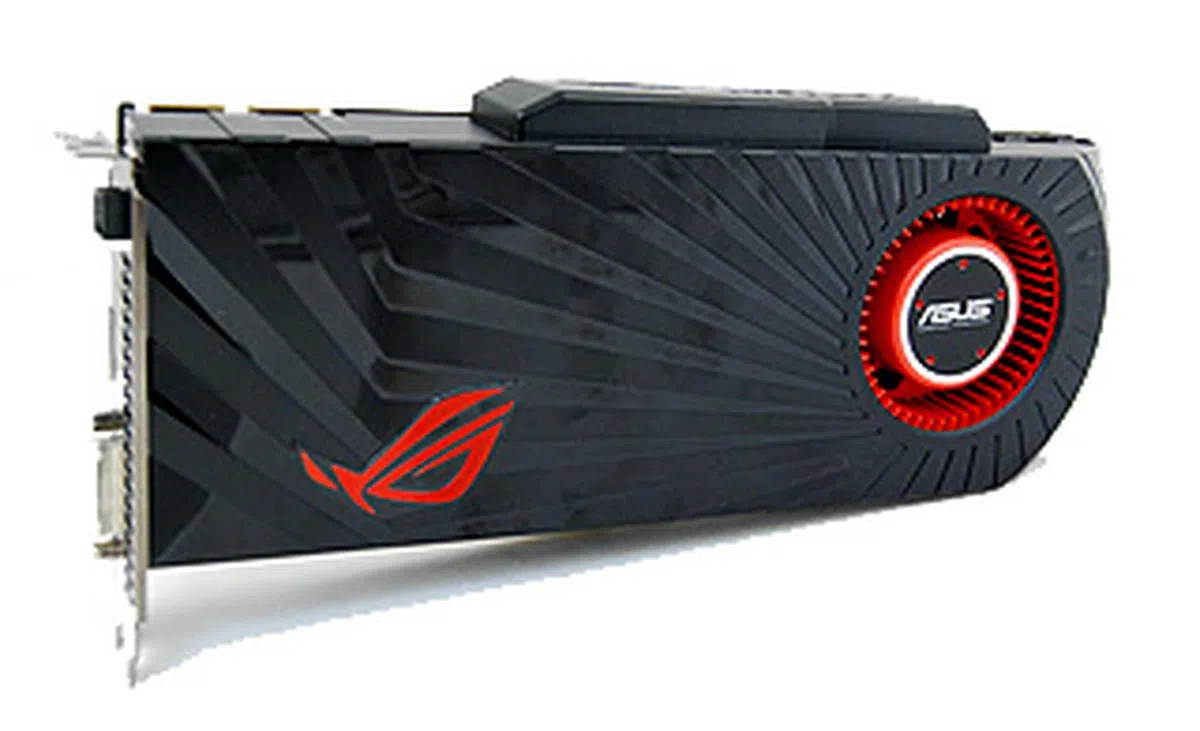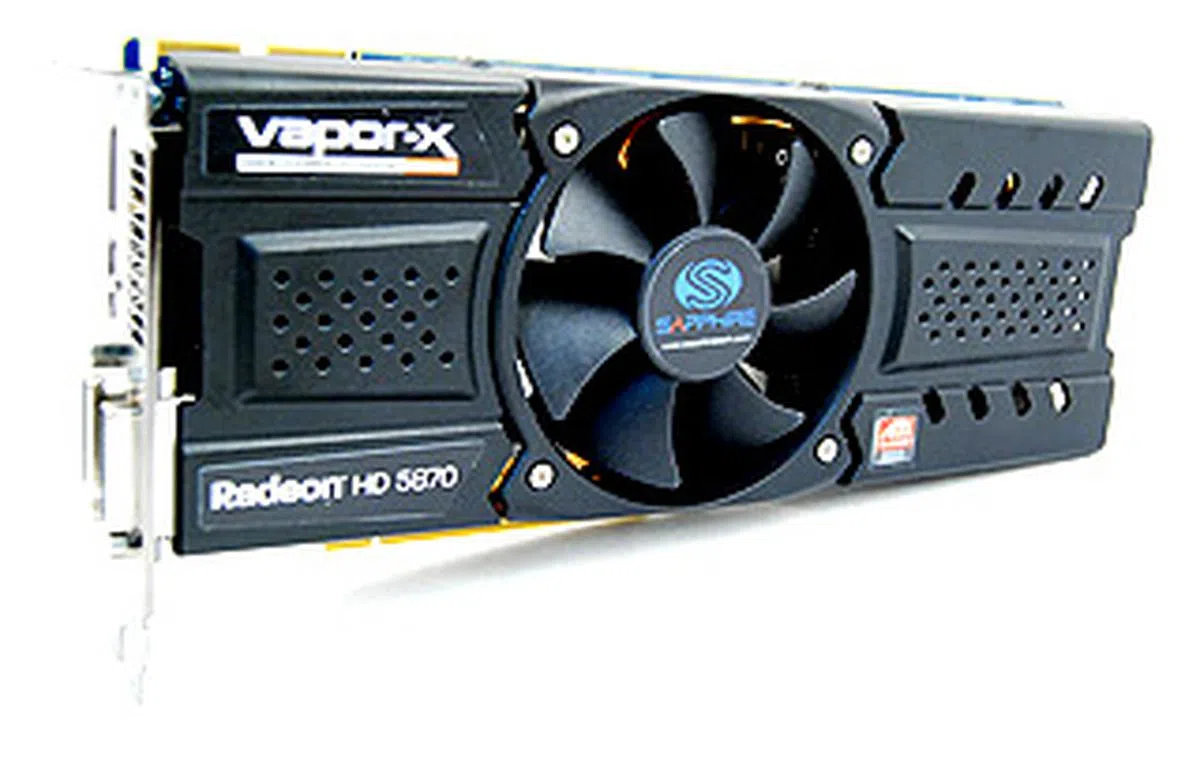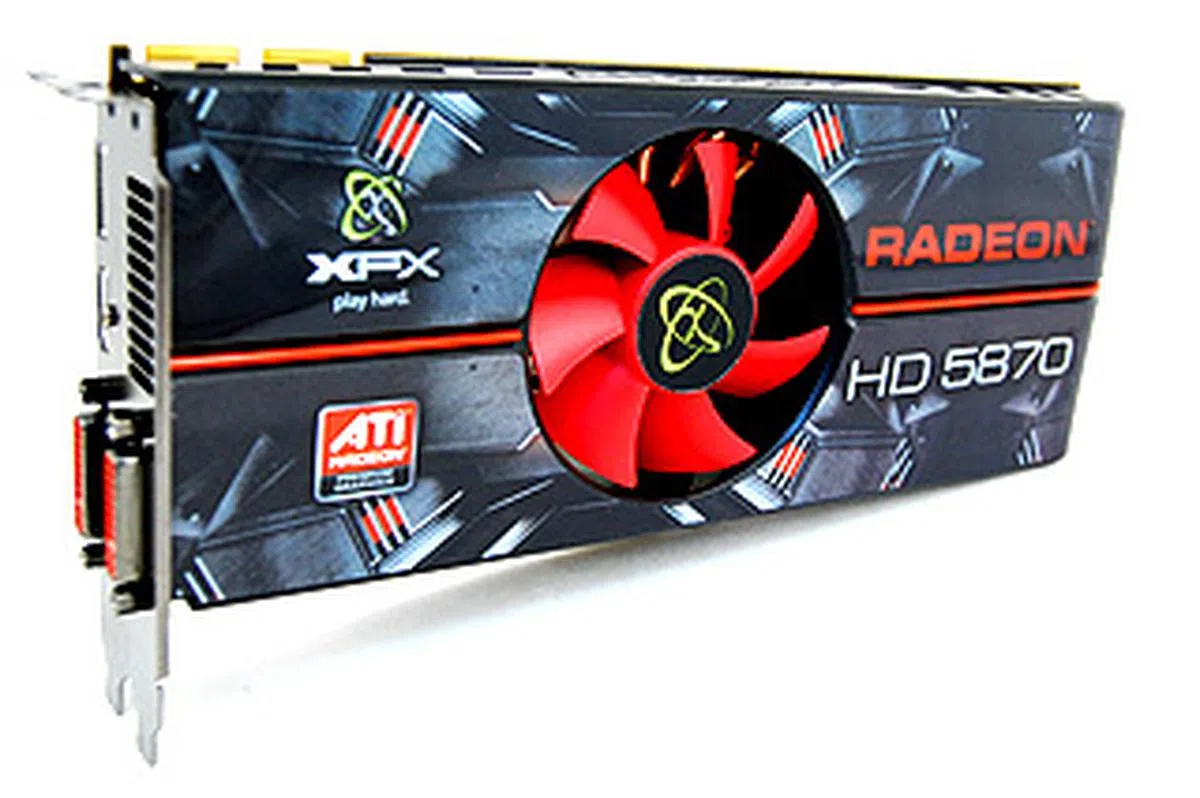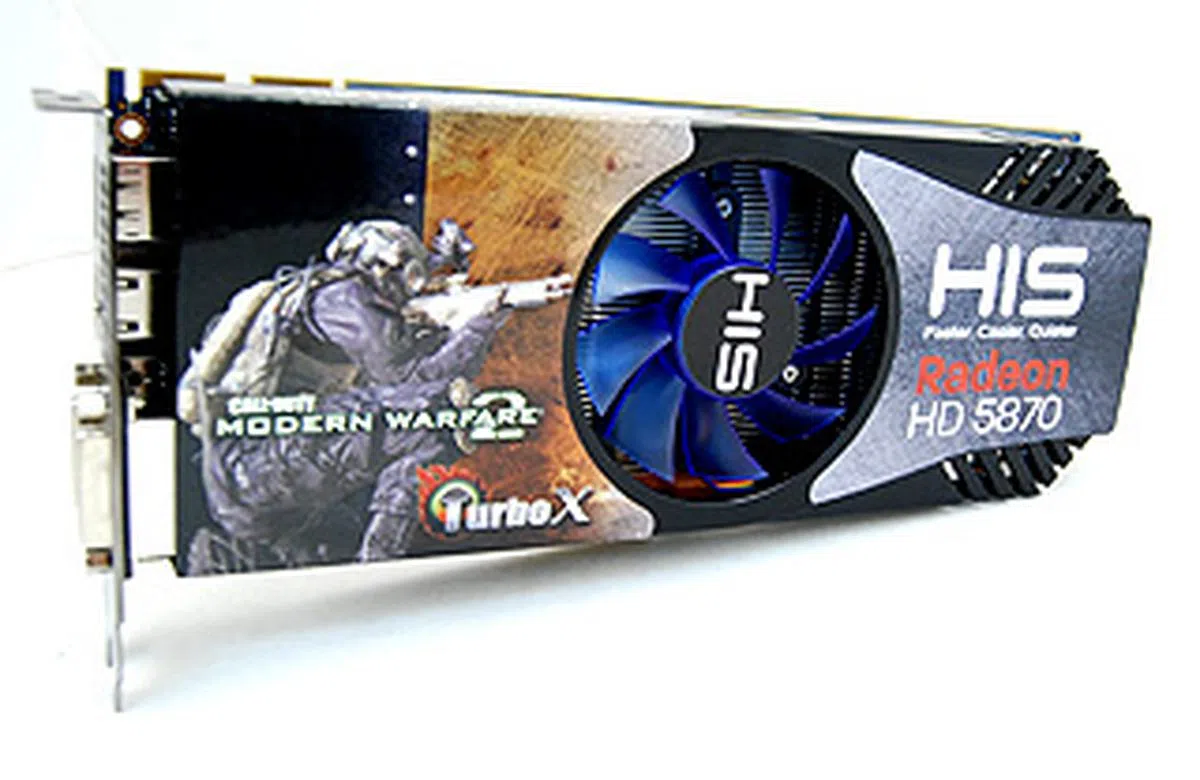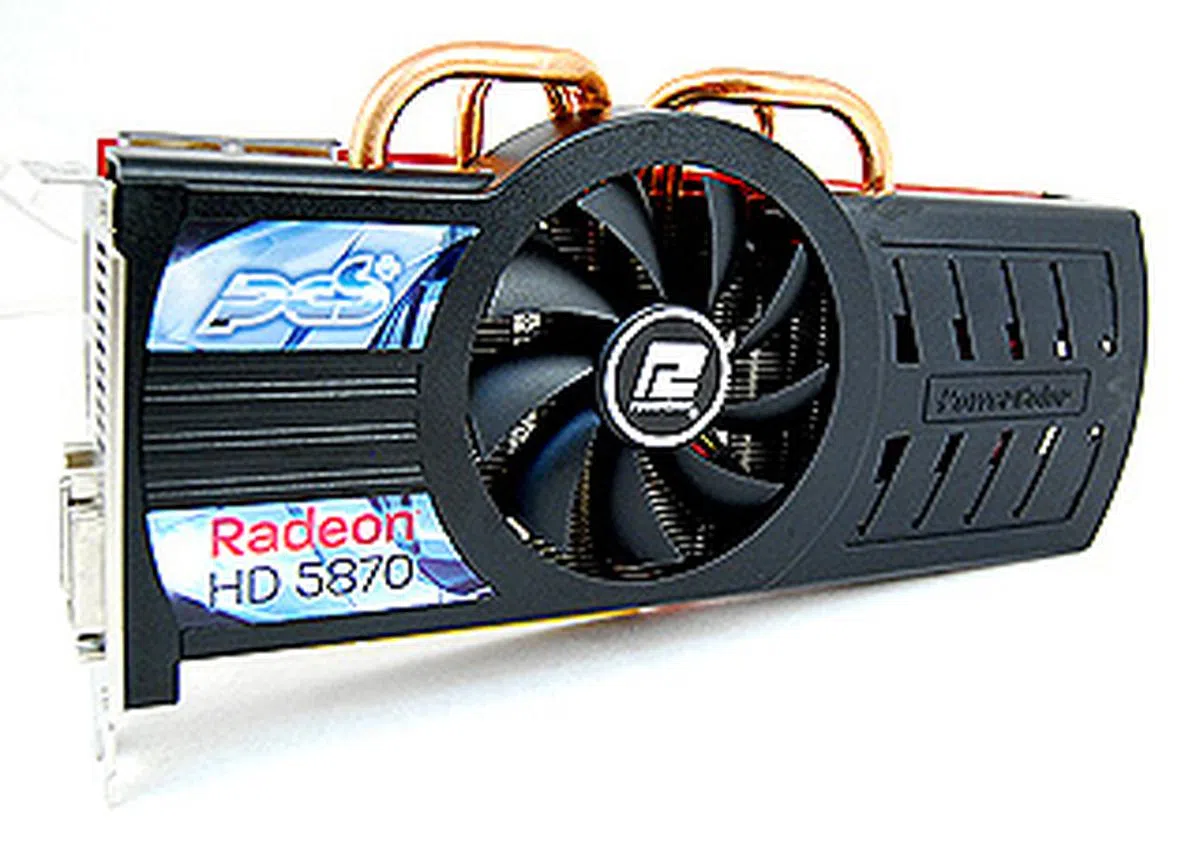Radeon HD 5870 Shootout - When Juggernauts Clash
We have gathered the fastest and coolest Radeon HD 5870 cards from the biggest names in the industry - ASUS, Gigabyte, HIS, MSI, PowerColor, Sapphire, XFX - all in the name of finding out who will reign supreme.
By Kenny Yeo -
Battle for Supremacy
Recently, we took a look at custom designed Radeon HD 5850 cards, now, we are focusing our sights on its more powerful compatriot, the Radeon HD 5870.
Launched in September last year, the Radeon HD 5870 was the world's first DirectX 11 compatible graphics card and also the fastest GPU of its time. It was markedly faster than its predecessor and was capable of pounding the uber-quick GeForce GTX 285 into submission. In fact, the only card that was capable of going toe to toe with it was the dual-GPU GeForce GTX 295, which is more costly and power hungry. All in all, we were exceptionally pleased with the Radeon HD 5870.
Even now, the Radeon HD 5870 remains to be ATI's flagship single GPU card, and continues to maintain its popularity amongst enthusiasts thanks to its unbeatable combination of performance, efficiency and relative affordability (against the GeForce GTX 480, at least).

Here's nearly $5000 worth of graphics processing power, and If we could link these seven cards together, we'll have a total thereotical compute output of a whopping 19.04 teraFLOPS!
To improve on the already capable Radeon HD 5870, vendors and partners of ATI are coming up with custom designed versions of the Radeon HD 5870. Often, these cards are factory overclock and boast customized cooling solutions to enhance the Radeon HD 5870's performance and efficiency.
Users looking to upgrade to a Radeon HD 5870 will be spoilt for choices, so to help you make your decision, we are rounding up the top models from the biggest names in the market. Here are our contenders for today's roundup:
- ASUS Matrix 5870 Platinum 2GB
- Gigabyte HD 5870 Super OC 1GB
- HIS HD 5870 iCooler V Turbo 1GB
- MSI R5870 Lightning 1GB
- PowerColor PCS++ HD 5870 1GB
- Sapphire HD 5870 Toxic Edition 2GB
- XFX HD 5870 XXX Edition 1GB
The ASUS Matrix 5870 Platinum
To be honest, we haven't had the best of experiences with ASUS's ROG lineup of Matrix graphics cards. While they boast an extensive list of features, performance was often underwhelming and they are usually very pricey to boot.
The ASUS Matrix 5870 Platinum is the company's flagship Radeon HD 5870. The card comes with the usual Matrix goodies such as ASUS' Super Hybrid Engine, which promises better performance, iTracker 2 overclocking utility and a customized cooler.
The card is also factory overclocked. The core is running at 900MHz – an increase of 50MHz – but memory clock speeds remain unchanged at 4800MHz DDR. That might not seem like a lot, but the card comes packed with a whopping 2GB of framebuffer. It'll be interesting to see if the extra framebuffer will have any impact on performance.

The ASUS Matrix 5870 Platinum might look like a reference card, but underneath, ASUS has given it many goodies to make it an overclocking beast.

The ASUS card makes do with one DVI, HDMI and DisplayPort. Note the "Safe Mode" button at the top left hand corner. It allows users to restore the card to its default settings should an overclocking attempt go awry.

The card displays different status lights to indicate how taxed it is. Red, for instance, means it is under heavy load. Here, it is showing blue because it is idling.

The iTracker2 overclocking utility is simple to use and boasts a wide range of parameters that you can play around with.
Gigabyte HD 5870 Super Overclock
Gigabyte has been somewhat quiet in the high-end customized graphics card scene but they are returning with a bang thanks to their latest offering, the HD 5870 Super Overclock. As its name suggests, the card is aggressively overclocked - 950MHz at the core and a full 5GHz DDR at the memory - making it the fastest card of the bunch in terms of sheer clock speeds out of the box.
To enable such high levels of specification, each GPU has been cherry-picked and specifically tested to endure the highest clock speeds. Furthermore, the Gigabyte HD 5870 Super Overclock also comes with a specially designed large dual-fan custom-designed cooler, top tier Samsung and Hynix memory, and Ultra Durable VGA components such as ferrite core chokes, solid capacitors and a 2oz copper PCB (following their successful formula on their motherboards business).
To be able to take full advantage of all these high-end components, the card also comes with the OC Guru software tuner which allows for easy tweaking of clock speeds and even the all important core voltage values.

With its dual fan coolers and thick protruding heat pipes, the Gigabyte HD 5870 Super Overclock looks nothing like a reference card.

The Gigabyte card gets twin DVI ports, and a single HDMI and DisplayPort.

According to Gigabyte, the odd curved shape of the cooler helps reduce air turbulence and allows for greater air flow and hence better cooling efficiency.

Gigabyte's OC Guro overclocking utility has a rather complicated user interface, but once you get the hang of it, you'll find that there's many aspects of the card that you can tweak.
HIS HD 5870 iCooler V Turbo X
Known for their outstanding custom coolers, HIS is taking the Radeon HD 5870 up a notch with their latest iCooler dual slot cooler. The new iCooler promises not only better cooling efficiency but also lower noise operating levels.
HIS has a couple of Radeon HD 5870 cards that come equip with the iCooler cooler, but ours is the top of the line Turbo X variant, which means it also comes factory overclocked. Clock speeds 900MHz at the core and 4900MHz DDR at the memory – an increase of 50MHz and 100MHz DDR respectively.
To sweeten the deal, HIS has also included a coupon that allows buyers to redeem a copy of the popular Call of Duty: Modern Warfare 2 game.

Like most custom-designed Radeon HD 5870 cards, the HIS one has its fan relocated to the middle, directly above the GPU core.

The HIS card gets the usual twin DVI ports, single HDMI port and single DisplayPort.

Numerous cooling fins help dissipate heat quickly and bring running temperatures down.
MSI R5870 Lightning
The MSI R5870 Lightning is no stranger to us, having reviewed it back in February this year, it is one of the earliest custom designed cards to be out in the market. You could say that the MSI R5870 Lightning became the card to beat and even to us, it is the benchmark for a well designed Radeon HD 5870 card on several aspects.
MSI's Lightning series of graphics cards are the company's best and the MSI R5870 Lightning lives up to its reputation. Armed with high-end components including highly conductive capacitors, solid state chokes, and multiple-phase PWM (pulse-width modulation) controller, the MSI R5870 Lightning is also factory overclocked.
That said, given the amount of fancy hardware it has, factory clock speeds are on the conservative side - 900MHz at the core and 4800MHz DDR. However, the previous time we tested it, the card was able to attain the magic 1GHz mark in our overclocking test, so it'll be interesting to see how it'll fare against newer opponents today.

The formidable MSI R5870 Lightning makes a return in our Radeon HD 5870 roundup. How would it hold up against new competitors?

The MSI card gets two DVI ports, a single HDMI and DisplayPort.

Twin fans and thick heat pipes help keep the card cool.

Developed in collaboration with RivaTuner, the MSI Afterburner is one of the cleanest and easiest to use overclocking utilities available today.
PowerColor PCS+ HD 5870
PowerColor's PCS+ line of cards represents the 'crack elite' from the company. PCS stands for Professional Cooling System and the PCS+ HD 5870 comes with a custom-designed cooler that has a large 90mm fan as well as four thick copper heat pipes, two of which are 8mm thick and the other two 6mm thick. The card comes factory overclocked, of course, but modestly – 875MHz at the core and 4900MHz DDR at the memory.

The 90mm fan employed by PowerColor is one of the largest we've ever seen on any graphics card.

The PowerColor card keeps up with the same two DVI ports and single HDMI and DisplayPort.

A close up of the card's four copper heat pipes.
Sapphire HD 5870 Toxic Edition
Sapphire's HD 5870 Vapor-X was one of the first custom designed Radeon HD 5870 to hit the market and they are back with a vengeance. Although this card sports the same vapor chamber technology cooler, it is more aggressively clocked. In fact, the Toxic Edition is running at 925MHz at the core and 4900MHz DDR – a substantial increase of 75MHz at the core and 100MHz DDR. Furthermore, the Sapphire HD 5870 Toxic Edition comes with 2GB of framebuffer, which might come in handy on the higher resolution, more intensive runs when we enable anti-aliasing. It's also a great choice if going for a CrossFire setup with more memory to aid two super fast GPUs.

The cooler of the Toxic Edition is identical to the one found on Vapor-X Edition, which we have reviewed previously.

The usual two DVI ports, single HDMI and DisplayPort.

Concealed by the cooler cover are thick copper heat pipes that help draw heat away from the GPU core.
XFX HD 5870 XXX Edition
Rounding up our list of contenders is the XFX HD 5870 XXX Edition. The card is clocked at 875MHz at the core, which is a little too conservative; but it makes up for that by having its memory clocked at 5000MHz DDR. It also comes with a customized cooler, which, on the outset, resembles ATI's reference design, with the only difference being the placement of the cooling fan. That aside, we must say that the color scheme of the XFX card is pretty attractive.

The XFX card looks somewhat similar to ATI's reference design, but we really dig its funky color scheme.

Again, we see the usual twin DVI and single HDMI and DisplayPort on the backplate of the XFX card.

We can see copper heat pipes peeking from underneath the cooler's fan.
Test Setup
The cards will be tested using our high-end X58 system with the following specifications:
- Intel Core i7-975 (3.33GHz)
- Gigabyte GA-EX58-UD4P motherboard
- 3 x 1GB DDR3-1333 OCZ memory in triple channel mode
- Seagate 7200.10 200GB SATA hard drive
- Windows 7 Ultimate
It'll be interesting to see how these super high-end Radeon HD 5870 perform against each other and how much performance improvement we can expect over a reference Radeon HD 5870. We will also be paying special attention to how their custom coolers perform as well as their overclocking performance.
The full list of cards tested and their driver versions:
- ASUS Matrix 5870 Platinum (Catalyst 10.3)
- Gigabyte HD 5870 Super Overclock (Catalyst 10.3)
- HIS HD 5870 iCooler V TurboX (Catalyst 10.3)
- MSI R5870 Lightning (Catalyst 10.3)
- PowerColor PCS+ HD 5870 (Catalyst 10.3)
- Sapphire HD 5870 Toxic Edition (Catalyst 10.3)
- XFX HD 5870 XXX Edition (Catalyst 10.3)
- Reference ATI Radeon HD 5870 (Catalyst 10.2)
The list of benchmarks used are as follows:
- Futuremark 3DMark Vantage
- Crysis Warhead
- Far Cry 2
- Warhammer: Dawn of War 2
- Battlefield Bad Company 2
- "Heaven" from Unigine
- S.T.A.L.K.E.R.: Call of Pripyat
3DMark Vantage Results
With its aggressive clock speeds, it wasn't a surprise seeing the Gigabyte HD 5870 Super Overclock snaring the highest scores on 3DMark Vantage. We also noted that the larger 2GB framebuffer on the ASUS Matrix 5870 Platinum and Sapphire HD 5870 Toxic Edition failed to give it an edge against its “lesser” 1GB brethren.

Crysis Warhead & Far Cry 2 Results
It was a tightly contested affair on Crysis Warhead, with all cards managing scores that were within one to two frame rates from each other. The difference is not going to be noticeable, but from the graphs, we can see that the Gigabyte card edges just ahead of the competition. And again, the ASUS and Sapphire cards fail to garner any sort of advantage with their larger 2GB framebuffers.


No surprises here as the Gigabyte HD 5870 Super Overclock once again emerged as the fastest card, albeit by the slightest of margins. The Sapphire HD 5870 Toxic Edition did well too, edging out the other slower clocked cards.


Dawn of War 2 & Battlefield Bad Company 2 Results
There was no clear leader on Dawn of War 2 as the cards all posted nearly identical results. Even a stock Radeon HD 5870 managed comparable scores.

While the cards were equally competitive on Battlefield Bad Company 2, we noticed that the Gigabyte HD 5870 Super Overclock was slightly faster than the rest, which is predictable considering it sports the highest clock speeds of the lot.

Unigine "Heaven" Results
Unigine was an interesting benchmark as we saw greater variances in performance. With its greater clock speeds, the Gigabyte card once again emerged as the fastest card. The Sapphire card was a close second, and it was a tie amongst the remaining five cards.




S.T.A.L.K.E.R.: Call of Pripyat Results
As the only two cards with their core clocked above 900MHz, the Gigabyte and Sapphire cards once again stood out for their slightly above average performances. The remaining five cards, with their comparable clock speeds, all managed frame rates that were comparable to each other.
DirectX 11 Results
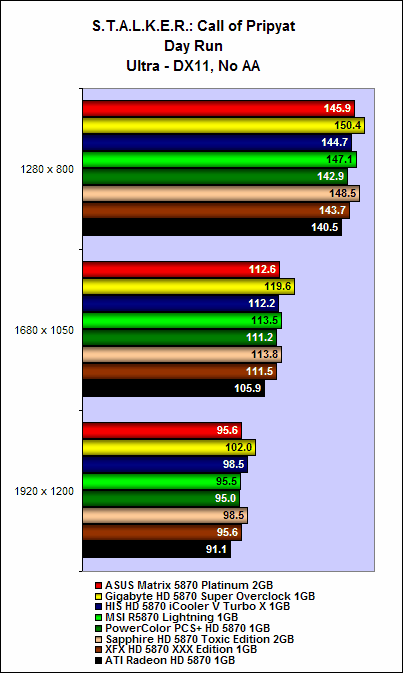 | 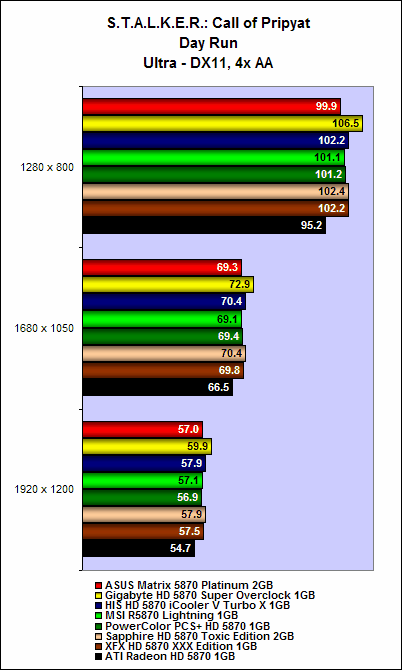 |
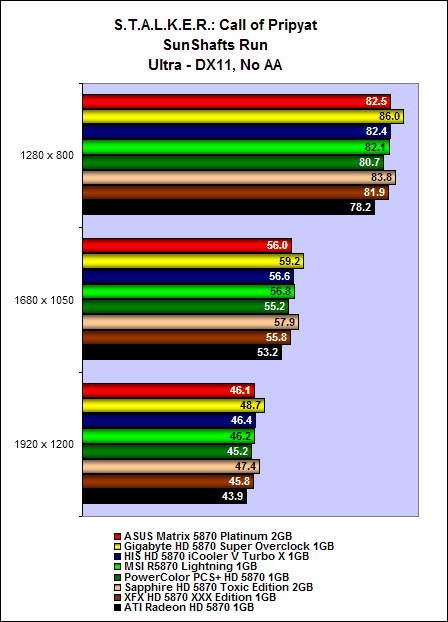 | 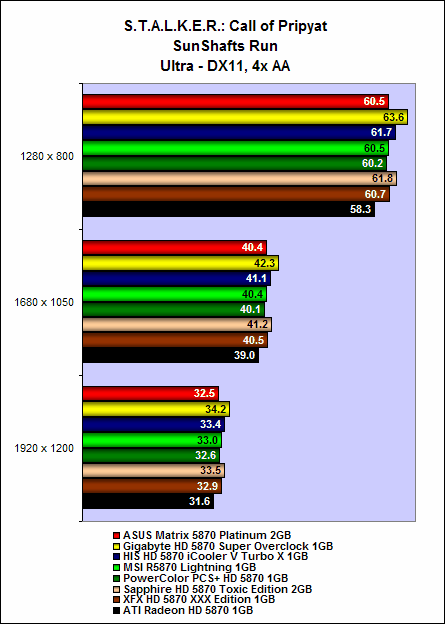 |
DirectX 10 Results
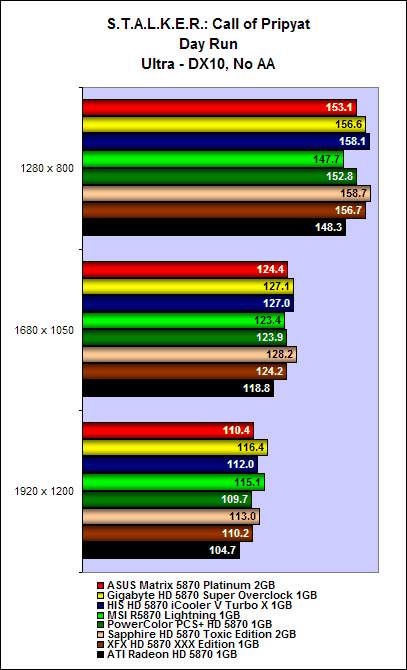 | 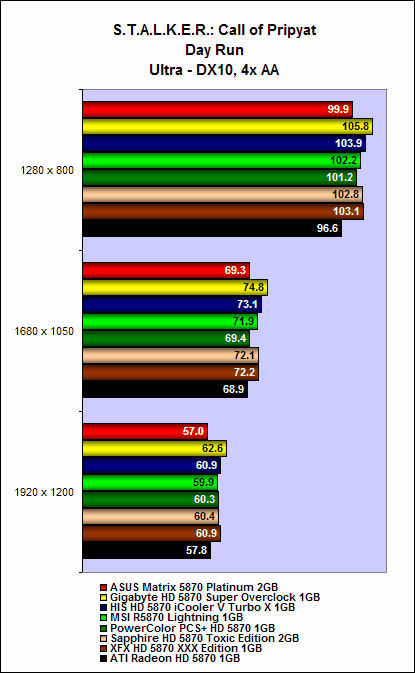 |
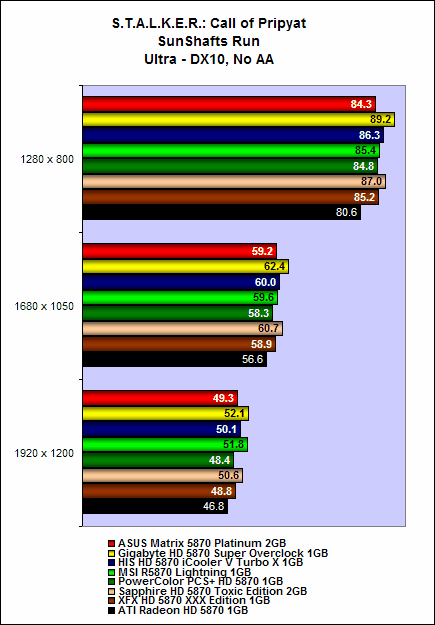 | 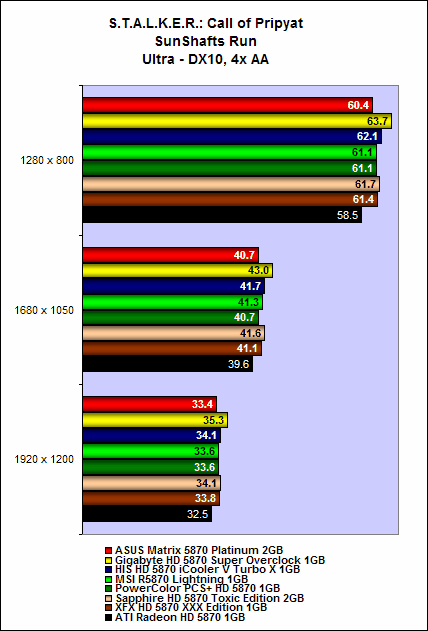 |
Temperature
In terms of outright performance, the cards were very competitive, so now we turn our attention to the efficiency of their custom-designed coolers. The most effective cooler is the one employed by the PowerColor PCS+ HD 5870. In fact, it was the only card to managed below 60 degrees Celsius when heavily taxed. Of course, one has to note that its clock speeds are also quite conservative and this lent is better operating temperatures as well.
The most disappointing cooler has to be the one found on the ASUS Matrix 5870 Platinum. Despite claims of being 13% cooler, we found that the ASUS Matrix 5870 Platinum card was just as hot as a ATI's reference-design card.
To add, the XFX's cooler was suffering from a problem whereby it won't throttle down properly when the card was idle. Even at idle, the fan would be spinning at 55% - 2500rpm - making a nuisance of itself. Hopefully XFX would rectify this problem with a BIOS update in the near future. Alternatively, one could always take matters into their own hands and tweak the fan speeds using ATI's Overdrive utility.
Overall, however, we are pleased with the cards' various coolers as most have managed to reduce operating temperatures quite dramatically.

Power Consumption
When it comes to power efficiency, we weren't surprised to see our factory overclocked cards recording slightly higher power draw as compared to a bone stock Radeon HD 5870. Fortunately, the increase isn't too massive. That said, we must comment that the power draw of both the Gigabyte and Sapphire cards is a bit on the high side.

Overclocking
With so many cards, we've decided to make things a little neater by showing the 3DMarks attained by the cards in their highest stable overclocking state. To make the graphs more meaningful, we've also included the percentage increase over their default performance on the left most side of each bar.
Using the bundled Gigabyte OC Guru software, which allows for a wide range of tweaking, we managed to get the card to run at an amazing 1030MHz at the core and 5200MHz DDR at the memory, which is easily the highest of the lot.
The ASUS Matrix 5870 Platinum did well too, achieving the greatest gains in performance (it has rather low stock clock speeds) and managing a full 1GHz at the core and 4900MHz DDR at the memory. Like Gigabyte's OC Guru, the bundled iTracker overclocking software allows for a wide range of adjustments including GPU and memory voltage values, and for the adventurous, even memory clock timings.
Using MSI's Afterburner overclocking utility, we managed to get the MSI R5870 Lightning up to 990MHz at the core and 5GHZ at the memory giving us 10123 3DMarks – an improvement of 7.5%.
On a whole, the cards all did fantastic in this segment. Even the lowest scoring PowerColor managed a full 100MHz increase on the core compared to a reference card, giving it an 11% overall improvement on performance against a bone stock Radeon HD 5870.

Our Verdict
On a whole, these custom-design Radeon HD 5870 offers significant improvements over ATI's reference design. Not only are they faster, but are also cooler to run and have greater potential for overclocking. To borrow a motoring analogy: if the Radeon HD 5870 is a fast car, then these custom-design cards are finely tuned racing machines.
On the subject of 2GB frame buffers, judging by our results, it can be said that it is going to be overkill for most users, seeing that the extra 1GB of framebuffer didn't give the cards an edge in our tests. However, for those contemplating multi-GPU CrossFireX configurations, multi-monitor setups, or are running on larger monitors capable of resolutions above 1920 x 1200, then that extra memory will come in handy. So keep this in mind when trying to decide if which framebuffer capacity to choose.
That said, it's time now to offer our analysis of these cards. Take note that for the Performance aspect of the ratings, it covers both raw performance and other performance matters like temperature, power draw and noise. Here's how they stack up against one another:
Cards | Performance | Features | Value | Overall | Price (USD) |
ASUSMatrix 5870 Platinum 2GB | 7.5 | 9 | 9 | 9 | $499 |
Gigabyte HD5870 Super Overclock 1GB | 9 | 9.5 | 8.5 | 9 | $499 |
HISHD5870 iCooler VTurbo X1GB | 8.5 | 8 | 8 | 8 | $499 |
MSIR5870 Lightning 1GB | 8.5 | 9.5 | 9 | 9 | $479 |
PowerColor PCS+ HD 5870 1GB | 8.5 | 8 | 8 | 8 | $460 |
Sapphire HD5870 Toxic Edition 2GB | 9 | 9 | 8 | 8.5 | $529 |
XFXHD5870 XXXEdition | 8.5 | 8 | 9 | 8.5 | $429 |
The Gigabyte HD 5870 Super Overclock is easily the most accomplished card of the group. Not only it is the fastest out of the factory, it also boasts many high-end features such as a dual-fan cooler, high quality memory chips, cherry-picked cores and voltage check points. Furthermore, it has great overclocking potential, seeing that managed to breach the 1GHz mark at the core. Its recommended retail price of US$499 is however a bit expensive. Sadly, for local readers hoping to get their hands on one, be prepared to pay an even bigger premium because it's priced at S$815 locally. For its capabilities, we're giving it the Winner and Overclockable awards to the Gigabyte HD 5870 Super Overclock.
Despite being the oldest card of the lot, the MSI R5870 Lightning remains very competitive, so kudos to that. It was released in early February and was the first Radeon HD 5870 to implement all these high-end overclocking features. And even in the face of fierce competition from Gigabyte and ASUS, the R5870 Lightning manages to hold its own. As such, it retain is Overclockable award along with Gigabyte. Its US$479 asking price is lower than that of both Gigabyte and ASUS and only serves to be the icing on the cake. Locally, it retails for around S$679.
The ASUS Matrix 5870 Platinum is our most value for money card of the lot and as such gets our Best Value award. Performance out of the box is a little lackluster due to its conservative clock speeds, but it is an able overclocker, enabling us to hit the magical 1GHz mark with consummate ease. But what we really like about the card is the fact that it comes with 2GB of framebuffer, despite costing the same as the Gigabyte, MSI and HIS cards. The benefits of the large framebuffer might not be apparent here, but for those running on larger 27 and 30-inch monitors and higher resolutions, the additional memory will go in a long way in speeding things up at ultra high resolution and settings. Folks looking to CrossFire these monster cards would also love the extra memory since having screaming fast GPUs isn't enough and they would require a decent amount of framebuffer for the best multi-GPU performance.

Of the seven, the Gigabyte, MSI and ASUS cards were our top picks. However, the Gigabyte HD 5870 Super Overclock shines through thanks to its strong all round performance. If only its asking price was more reasonable, it would have scored even higher.
The Sapphire HD 5870 Toxic Edition is a decent card with fine all-round capabilities. It is quick right out of the box and its cooler did a respectable job of keeping things cool. On top of that, we were pleased with its overclocking performance, almost attaining a 1GHz mark at the core and reaching an unbelievable 5200MHz DDR at the memory. Like the ASUS card, it too comes with 2GB of framebuffer; but unlike the ASUS, this card will cost you more at US$529.
The XFX HD 5870 XXX Edition is the budget pick of the group, considering its the least expensive at US$429. Locally, the card can be had for S$649. And for that money, you'll get a card that offers decent all-round performance. Our only gripe was the fan kept spinning at a noisy 2500rpm, even when the card is idling. That aside, the card is an excellent 'entry-level' choice on the other end of the scale.
The HIS HD 5870 iCooler V Turbo X would have been a good card on its own, but in face of such stiff competition, it looks a little bland. The custom cooler works well to keep operating temperatures down, but we found its factory clock speeds to be too unexciting. That aside, the card does offer a redeemable copy of Modern Warfare 2, so if you are fan of FPS games and you don't need the overclocking utilities offered by the other cards, then this card is worth considering. However, the price is also expensive for its offerings.
Rounding up the pack is the PowerColor PCS+ HD 5870. Although it is the coolest operating card, it is lacking in the performance and features department in this stiff competition. Its factory clock speeds are the lowest and apart from the PCS+ custom cooler, it has little else that makes it stand out from the rest. Its overclocking performance is also nothing to get excited over. At US$460, it is on the pricey side, since cards like the MSI R5870 Lightning are only US$20 more. If you're a die-hard PowerColor user and want to keep your next upgrade within the family, you might want to consider hunting for the limited edition PCS++ version of the Radeon HD 5870 series which offers even higher clock speeds.
| |
| |
|
|
| 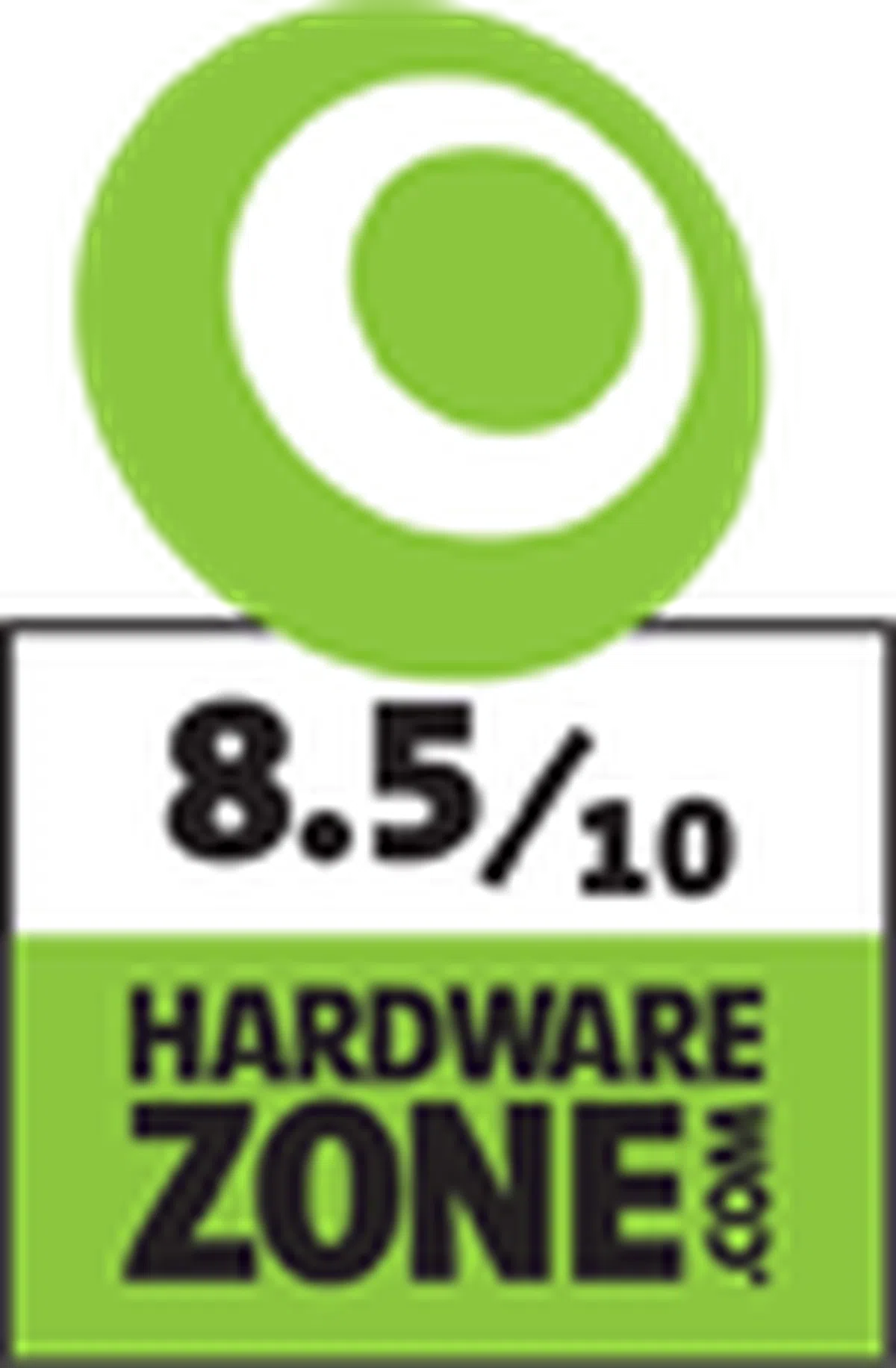 |
|  |
|  |
|  |
Our articles may contain affiliate links. If you buy through these links, we may earn a small commission.
